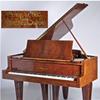A Major Exhibition of Historic Spanish Fashion Paired With Period Paintings Debuts at Meadows Museum in September
- June 10, 2021 16:03
The Meadows Museum, SMU, Dallas, has announced a major exhibition of Spanish dress and fashion that will pair paintings from the Meadows’s collection with historic dress and accessories from the Museo del Traje, Centro de Investigación del Patrimonio Etnológico in Madrid. Canvas & Silk: Historic Fashion from Madrid’s Museo del Traje marks the first major collaboration between this important Spanish institution and an American museum and will include approximately 40 works from the Meadows alongside examples of dress and accessories from the Museo del Traje (Spanish National Museum for Fashion).
Displayed together, the works in the exhibition not only tell the story of how fashion trends in Spain changed over five hundred years, but also reveal how elements of a country’s history – such as its involvement with global trade or the formation of a national identity – are reflected in its dress. Canvas & Silk will be on view at the Meadows from September 19, 2021, until January 9, 2022. Concurrently, the Meadows will also present Image & Identity: Mexican Fashion in the Modern Period, an investigation into Mexican dress spanning from Mexican Independence to modern times through photographs and prints from the collections of the Meadows Museum and SMU’s DeGolyer Library.
“We are thrilled to have the opportunity to gain further insight into the Meadows’s collection of Spanish art through its exhibition with loans from Spain’s premier collection of historic dress,” said Amanda W. Dotseth, curator at the Meadows Museum and co-curator of the exhibition in collaboration with Elvira González of the Museo del Traje. “This exhibition makes it possible to tell a more nuanced story about Spanish society through the presentation of historic paintings with contemporaneous examples of the garments depicted therein. We are as never before able to explore the complex relationships between representation and reality, or between image and artifact. Spanish fashion has long been a point of interest for the Meadows Museum, whether in the form of past exhibitions – such Balenciaga and His Legacy: Haute Couture from the Texas Fashion Collection in 2007 – or as portrayed in the collection’s prints, paintings, and sculptures. We look forward to continuing our study and display of Spanish fashion with this unprecedented collaboration with the Museo del Traje.” Canvas & Silk will be divided into themes that elucidate various trends in the history of European fashion in general and Spanish dress in particular over the past five hundred years.
These include “Precious Things,” featuring accessories like jewelry and combs made from precious metals and other rare materials such as coral; “Traditional Dress” with examples of garments and ensembles that are typically identified with Spain, such as a traje de luces (the suit typically worn by bullfighters) and mantón de Manila (traditional embroidered silk shawls
historically traded through Manila); and “Stepping Out” demonstrating the importance of what one wore when presenting themselves in public. Highlights of pairings combining paintings from the Meadows’s collection and historic dress from the Museo del Traje include Ignacio Zuloaga’s The Bullfighter “El Segovianito” (1912) accompanied by a traje de luces of the same color; Zuloaga’s Portrait of the Duchess of Arión, Marchioness of Bay (1918) displayed alongside a mantón de Manila similar to the one the duchess is holding; and Joan Miró’s Queen Louise of Prussia (1929) paired with a vibrantly hand-painted dress and shoes by twentiethcentury fashion designer Manuel Piña.
“By pairing the Museo del Traje’s collection with that of the Meadows’s, we are bringing the dress, accessories, and other material objects to life, enabling viewers to see the contexts in which such articles were worn,” said Elvira González, curator of the historic apparel collection at the Museo del Traje. “Viewed together, the clothing allows for a deeper understanding of the painting; for example, the presence of the mantón de Manila (embroidered Manila silk shawl) in Ignacio Zuloaga y Zabaleta’s painting Portrait of the Duchess of Arión, Marchioness of Bay (1918) speaks to the social position of the woman depicted. Not only will our collection be seen by audiences in the U.S. for the first time, but it will also be displayed in a completely new light. We’re excited to see what kind of scholarship and new ideas might be generated by presenting these works in a new environment and alongside these paintings and drawings.”
The accompanying exhibition catalogue will contain an essay co-authored by Dotseth and González that illuminates themes linking the garments, accessories, and corresponding works in the Meadows collection. The publication will feature new photography of key objects by Jesús Madriñán.
Canvas & Silk will be accompanied by a focused exhibition in the museum’s first-floor galleries titled Image & Identity: Mexican Fashion in the Modern Period, curated by Akemi Luisa Herráez Vossbrink, the Center for Spain in America (CSA) Curatorial Fellow at the Meadows Museum. Featuring photographs, prints, books and gouaches from the 19th and 20th centuries, this exhibition will explore Mexican fashion through images of everyday scenes, festivities, regional types and occupations. Building on a theme developed in Canvas & Silk, Image & Identity will also show how national identity formation is reflected in fashion and is often accompanied by a resurgence in the popularity of indigenous dress. Works in Image & Identity are drawn from the collections of the Meadows Museum and SMU’s DeGolyer Library, named after Everette L. DeGolyer, Sr. who, with his son, collected maps, books, manuscripts, and photographs related to Mexican exploration and history. Artists featured in the exhibition include Alfred Briquet, Carlos Mérida, Diego Rivera, José Clemente Orozco, Jerry Bywaters, Paul Strand and Manuel Álvarez Bravo.





















